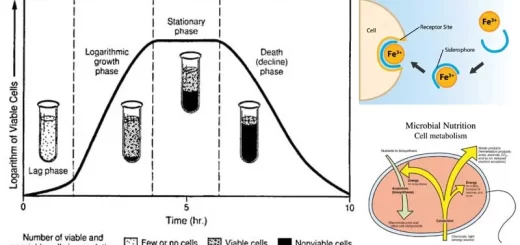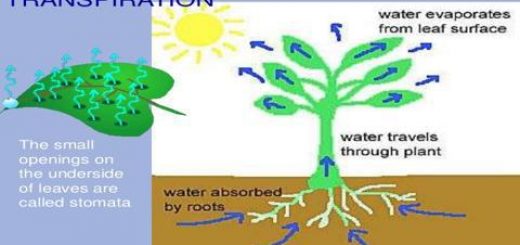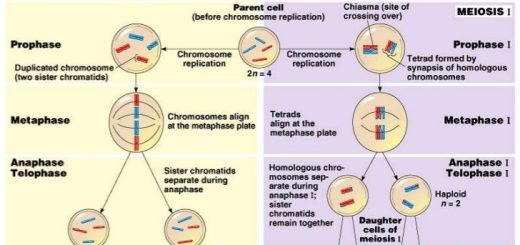Types of reproduction in plants, Typical flowers Structure and sex of flower
Living organisms perform seven vital processes which are: Nutrition, Respiration, Growth, Excretion, Sensation, Reproduction & Motion. All these vital processes aim to continuity the life of the living organism except the “Reproduction process” which aims to continuity its species and protects it from extinction and the life of the individual doesn’t depend on it.
Reproduction process
It is a vital process that aims to secure the existence and continuity of living organisms species by producing new individuals of the same species to prevent them from extinction.
Types of reproduction in plants
There are two kinds of reproduction in plants:
- Sexual reproduction through male and female reproductive organs in flowers.
- Asexual reproduction through the various vegetative parts of the plant except for flowers.
Sexual reproduction in Plants
The flower is a short stem whose leaves are modified to form genital (reproductive) organs which in turn form seeds inside fruits, The flower is the organ of sexual reproduction in flowering plants.
Origin of the flower
It arises from a floral bud that emerges from the axle of a leaf called a bract. Bract is the green leaf, where the floral bud emerges from its axle and developed into a flower. The axle may carry some flowers which are known as inflorescence. An inflorescence is a group of flowers carried on the same axle.
Structure of the flower
If you examine a flower, you will notice that the flower has a thin neck (pedicle) that ends in a swollen part (receptacle) that carries the floral leaves in four different floral whorls:
Receptacle
It is the swollen part upon the flower pedicle, on which the floral leaves exist.
Four different floral whorls
1. Calyx
The calyx is the first (outermost), whorl of the floral leaves, It consists of a group of green leaves, and each leaf is called a “sepal”, Its function: It protects the inner parts of the flower, especially before blooming.
2. Corolla
It is the second whorl (following the calyx) of the floral leaves. It consists of a group of bright-coloured scented leaves, each leaf is called a “petal”. Its function: It protects the reproductive organs. It attracts insects to the flower, which helps in the reproduction process.
3. Androecium
It is the third whorl (following the corolla) of the floral leaves, It is the male reproductive organ of the flower, Its leaves are known as “stamens”. Each stamen consists of a fine filament that ends in a sac known as the anther, which is divided into two parts, each part has two chambers containing pollen grains. Its function: It produces pollen grains (inside the pollen chamber).
4. Gynoecium
It is the fourth (innermost) whorl of the floral leaves, It is the female reproductive organ of the flower, Its leaves are known as “carpels” which resemble a flask in shape. Each carpel consists of a swollen part called the ovary, which is connected with a tube called the style, which ends in an opening called the stigma, It produces ovules (inside the ovary).
Typical flower
The flower is considered a typical flower if it contains four different floral whorls. The typical flower is a flower that contains four floral whorls. Flowers are different from each other in the separation or fusion of the sepals and petals, like in the flowers of wallflowers (Manthoor) and Petunia.
The petals of the corolla are colourful and scented to attract insects to the flower which helps in the sexual reproduction process. The androecium is the male reproductive organ of the flower because it produces pollen grains. The gynoecium is the female reproductive organ of the flower because it produces ovules.
The sepals of the calyx and petals of the corolla might be of the same shape and colour as in an onion flower. that’s why we call the two whorls together the perianth. Hay fever is a disease infecting people who have an allergy to pollen grains, the symptoms of this disease are: inflammation of the mucus membrane of the nose, running nose, continuous sneezing, and tear flow.
Sex of flowers
Flowers are classified according to sex into two types which are Bisexual flowers and Unisexual flowers:
- Bisexual flower (hermaphrodite): A flower that carries both male and female reproductive organs. Examples: Flowers of most plants such as Flax, Tulip, Petunia, and Wallflower.
- Unisexual flower: Flower that carries either male or female reproductive organs only. Examples: Flowers of some plants such as Palms, Maize, and Pumpkins.
The flower of the tulip plant is a bisexual flower because it contains both stamens and carpels together. The flowers of palms are unisexual flowers because some of them contain only male reproductive organs (stamens) and others contain only female reproductive organs (carpels). The flower of the bean plant is a typical bisexual flower because its flower contains four whorls.
Drying-flowers
Pick up a bunch of flowers and remove the lowermost leaves from the flower pedicle, and organize them in groups to be tied to the pedicle. Hang them in an upside-down position in a dark, well-ventilated room for one week.
Importance of Flowers
Flowers are essential for the sexual reproduction of flowering plants. They play a critical role in several aspects of plant life:
Reproduction: Flowers are the primary sites of sexual reproduction in flowering plants. Pollen grains produced by the stamens are transferred to the stigma of the pistil, either by self-pollination or by pollinators. This leads to fertilization, the fusion of male and female gametes, which results in the formation of seeds.
Attracting Pollinators: The bright colors, scents, and nectar produced by flowers serve to attract pollinators, such as insects, birds, and bats. These animals transfer pollen grains between flowers, facilitating cross-pollination, which increases genetic diversity in offspring.
Fruit Development: After fertilization, the ovary of the flower develops into a fruit, which protects and disperses the developing seeds. Fruits also serve as a source of food for animals, who help disperse seeds to new locations.
Beauty and Aesthetics: Flowers come in a wide variety of shapes, sizes, colors, and fragrances. They play a significant role in human culture and are appreciated for their beauty and symbolism. Flowers are used for decoration, in religious ceremonies, and as expressions of love, sympathy, and celebration.
Pollination is the transfer of pollen grains from the male part of a flower (anther) to the female part of a flower (stigma). Pollination can occur within the same flower (self-pollination) or between different flowers of the same species (cross-pollination). Cross-pollination is generally preferred as it leads to greater genetic variation, which increases the plant’s chance of survival in a changing environment.
Fertilization: If pollination is successful, fertilization occurs when a pollen grain germinates on the stigma and sends a pollen tube down the style to the ovary. The sperm cells in the pollen tube travel down the pollen tube and fuse with the egg cells in the ovule.
Fruit and seed development: After fertilization, the ovary of the flower ripens into a fruit, and the ovules develop into seeds. Fruits and seeds help with dispersal and germination of the plant’s offspring.
Overall, flowers are essential for the continuation of flowering plants. They ensure the production of seeds through sexual reproduction and allow plants to disperse their offspring to new locations.
Asexual and sexual reproduction in plants, Pollination and Stages of fertilization process in plants
Pollination, Fertilization, Seed and Fruit formation in flowering plants
Reproduction in flowering plants, Structure and functions of the flower
Transportation in plant, Structure and role of the plant stem in the process of transportation
Autotrophic Nutrition in green plants, Mechanism of water and minerals absorption



